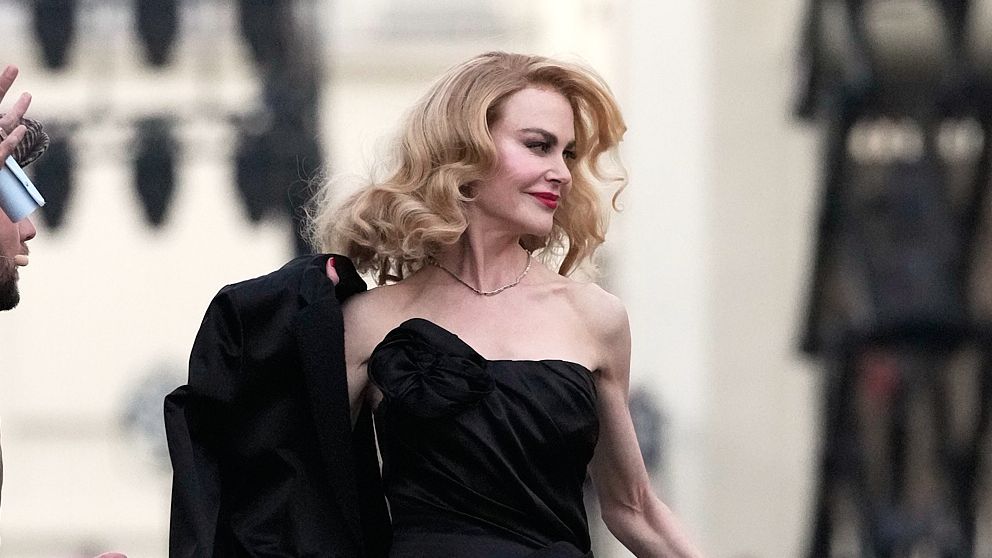As the sun set over the Hollywood Hills, the lights went up at Paramount Studios, the setting for tonight’s fourth edition of Vogue World. Nicole Kidman, doing her best Gilda in a custom-made strapless black Chanel dress, stalked down the runway, vamping for the camera, taking direction from Baz Luhrmann: “Let’s hear it from the audience. Extras, extras, give it to us, extras… Keep the focus… and hold, and the hair, she sees her future, hold the thought, keep the focus, and… cut.” With that, the show began.
Like its predecessors in New York, London, and Paris, Vogue World: Hollywood celebrated the city in which it took place. In particular, this year’s runway spectacular, which was styled by frequent Vogue contributor Alex Harrington, put the spotlight on the enduring connection between fashion and film, showcasing the output of the most accomplished and influential women costume designers of the last five decades.
“It’s thrilling to be very specific about the common thread—don’t mind the pun—between fashion design and costume designers, as well the distinct differences,” Arianne Phillips told Vogue. “It’s a conversation that we as costume designers are well aware of when we see how the culture expands around a film. We all know films, like Annie Hall, or Star Wars, that have informed not only the way we dress, but the way we think.”
After magic hour cocktails that included such star sightings as Venus Williams, Kathryn Hahn, Karol G, and Alex Consani’s parents Lisa and Anthony, the show rolled out in seven acts, with a costume designer leading each one: Up first was Hollywood Glamour, a subject Catherine Martin, Luhrmann’s wife and filmmaking partner, knows a thing or two about, having won costume design and production design Oscars for both Moulin Rouge! And The Great Gatsby. This section was all razzle dazzle, with Prada looks from Gatsby, gowns from Alessandro Michele’s Gucci show on Hollywood Boulevard a few years back, and a bejeweled flapper dress from one of the late Giorgio Armani’s final collections.
Anok Yai, modeling a reproduction of Johnny Depp’s elaborate Colleen Atwood-designed Edward Scissorhand’s get-up, led the Renegades section, which also included cameos by musician Quintess Swindell and actor Kodi Smit-McPhee as Alice in Wonderland’s Alice and the Mad Hatter. Barry Lyndon and Marie Antoinette’s Milena Canonero—who else?—was the woman behind Historical Heroines. This theme gave Harrington a chance to go really vintage: There were circa 2004 John Galliano gowns for Dior in the mix alongside new-season pieces by up-and-comers like Vaquera and August Barron.
Gracie Abrams, wearing spring 2026 Chanel by Matthieu Blazy and performing Carole King’s 1971 hit, “I Feel the Earth Move,” and her own chart topper “That’s So True,” kickstarted the Summer of Love, which featured looks from a trio of movies costumed by Phillips: Once Upon a Time in Hollywood, Walk the Line, and A Complete Unknown. Scarlet White (daughter of Jack White and Karen Elson) did her best June Carter Cash in the dress that helped Reese Witherspoon land her first Oscar, and Lila Moss channeled her mama Kate in festival-ready Valentino.
Hunter Schafer looked like a latter day Tilda Swinton in Sandy Powell’s Orlando costume, heading up the Renaissance Rock chapter. Proving the show’s thesis, that influence goes back and forth between fashion and film in an endless circle, Powell’s glam rock Velvet Goldmine suits and Nicolas Ghesquière’s sparkling 18th century-ish frock coats looked like kissing cousins, and Michele’s haute couture Valentino, brought to life by Consani (get that woman a movie deal!), could’ve done double-duty on the Orlando set.
Next up were Danai Gurira and Teyana Taylor playing Dora Milaje warriors and Angela Bassett, reprising her role as Queen Ramonda, and earning gasps from the audience as only a royal can. Black Panther costume designer Ruth E. Carter helmed the Afro-Futurism chapter; pieces from the late Virgil Abloh and emerging African labels Iamisigo and Orange Culture, along with custom-made dancer costumes from Balmain’s Olivier Rousteing were included here.
The final act was bookended by a Freman costume from Dune’s costume designer Jacqueline West, and a sensational gown from Glenn Martens’s Maison Margiela Artisanal debut worn by Awar Odhiang. In between, Matthew Noszka sported Leonardo DiCaprio’s Revenant costume (thankfully there was no accompanying grizzly bear) and Doja Cat was a very believeable Tina Turner in Mad Max: Beyond Thunderdome; her outfit was made by Michael Schmidt, who often worked with the late pop superstar.
As many celebs as there were on the runway, there were more in the front row, Miley Cyrus, Dakota Johnson, Viola Davis, and Gwyneth Paltrow included, along with a who’s who of designers, among them Nicolas Ghesquière, Anthony Vaccarello, and Zac Posen. California governor Gavin Newsom even turned up. Ticket proceeds from Vogue World: Hollywood reached $4.5 million, all of which will go to the Entertainment Community Fund, a national human services organization addressing the needs of people who work in performing arts and entertainment.
Now and then, other memorable characters from the movies, curated by Everything Everywhere All at Once’s Shirley Kurata, walked by, whispering with their cast mates, or waving hello to a star from another film. From one direction came Marilyn Monroe in The Seven Year Itch, as reimagined by Marc Jacobs, from another Thom Browne and Vivienne Westwood interpretations of Clueless tweeds, and was that a tip of the proverbial bowler hat to Charlie Chaplin’s masterpiece Modern Times via spring 2011 John Galliano? Yes, yes it was.
Model Betsey Gaghan strolling up the runway in Diane Keaton’s iconic Annie Hall khakis, vest, and tie (thank you, Ralph Lauren), with her song “Seems Like Old Times” on the soundtrack, was one of the show’s most resonant moments. As Phillips said, great films make us think. The very best ones make us feel. Vogue World: Hollywood captured a little bit of that movie magic. “Good Vibrations” all around.

